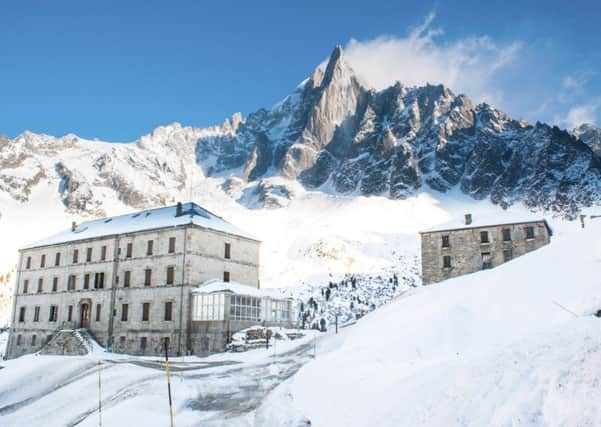Travel: Making tracks to Chamonix on the Eurostar


I have never got off a train in Lille. Hitherto, like many Euro travellers, I’ve regarded Lille Europe station as a mere hiatus between the delights of Ebbsfleet in Kent and the fleshpots of Brussels. But the brand new Eurostar service to Geneva, unveiled late last year, suddenly provides a good reason to disembark in that unappetising glass and concrete concourse. There is just enough time to grab an espresso, pay 50 cents for a trip to the loo and board the connecting TGV to Geneva.
“We are so happy to welcome you on board,” says the voice on the tannoy as we plunge south through France. “Welcome to our inaugural journey!”
Advertisement
Hide AdAdvertisement
Hide AdIn four hours I will be in Geneva, and an hour after that in Chamonix. Total journey time: six and a half hours from St Pancras. Compare that with the wintry uncertainties of a flight and, suddenly, taking the train is not just the green option – it’s a viable, fast alternative when seeking the slopes of France and Switzerland. Skiers even get an extra item in their baggage allowance, such as a pair of skis or a snowboard.
And, of course, when I get to the railway terminus in Geneva there is no passport queue, no luggage carousel roulette, no having to go to oversize baggage to collect skis. I just walk out of the station and clamber into the waiting Mountain Drop-offs minibus.
I sleep on the journey to Chamonix while Anton the driver listens to techno-funk as we speed through darkness into the Arve valley. Suddenly Anton slams on the brakes and there it is: Chalet Les Tissourds, with a view of Mont Blanc above and a glass-fronted modern fireplace being tended by a cheery South African called Kirsteen (another option is the more rustic Mazot Les Tines). After a glass or two of equally cheery local wine I’m asleep. Apart from Anton’s dubious choice in music, it’s been an effortless journey to the slopes.
FOLLOW US
SCOTSMAN TABLET AND MOBILE APPS
The next morning Kirsteen makes coffee and it’s definitely time to see Chamonix. The rest of my party – and the snow – is supposed to be arriving in two days’ time, although I’m told at the tourist board that they’ve been promised the white stuff for weeks.
My guide takes me to the statue of Horace-Bénédict De Saussure, the 18th-century scientist who brought rationalism to these mountain villages. Until De Saussure offered a monetary prize for the first person to get to the top of Mont Blanc, locals avoided the peaks, believing dragons lived up there.
I pass a mural commemorating Edward Whymper, who arrived here to sketch in the 1860s and ended up conquering every summit. At the Protestant church I see the grave of Captain Henry Arkwright, who fell into a glacier in 1860 and was not buried until 31 years later when it finally spat him out in a giant ice cube.
The British loved Chamonix – and still do. Currently 15 per cent of the permanent population is British. Sadly, Chamonix’s very fashionability means locals can no longer afford to live here.
After an energy-giving lunch of Black Angus beef followed by marshmallows at Hotel Le Morgane’s Le Bistrot restaurant, run by one-Michelin-starred chef Mickey Bourdillat, I take the slow train up to La Mer de Glace, 900m above Chamonix. The little red clockwork train grinds up a route that until 1909 was only accessible by foot or mule.
Advertisement
Hide AdAdvertisement
Hide AdJust 25 minutes later, our small party of families trying to entertain their snow-deprived children gets out onto the platform at Montenvers and gazes down at the remains of the Mer, a massive glacier that entranced Goethe, Liszt and hundreds of British Alpinists who came here to paint watercolours and scamper about on the ice.
However, it looks like someone has pulled the plug. You can see the height that the glacier flowed at in 1820 etched into the rock face 200 metres above its current surface. According to my guide, the Mer de Glace used to flow pretty much all the way down to Chamonix. In 50 years’ time it may have retreated out of sight. Call it climate change if you will, but something is up. The Petit Dru, a 3,750m peak opposite Montenvers, gets thinner every year because it’s no longer protected from the elements by its permanent coating of ice. As I take in the view, I can hear rocks splitting and rolling down into the glacier.
But it is a magnificent view nonetheless. I warm up with a drink in the Grand Hotel du Montenvers, whose deep wood-panelled windows frame the view perfectly, just as they did when it opened in 1880. As the sun begins its retreat, the mountain tops colour a wonderful Alpine pink.
There is an irony that the slopes are changing even as we’re getting to them quicker. Still, I’ve done my bit to save the Mer de Glace and the Petit Dru by coming here by train. I just wish the others would hurry up – and bring some snow.
• Eurostar departs daily from St Pancras International to Geneva, returns from £116, eurostar.com. Mountain Drop-offs offers private minibus transfers from Geneva to Chamonix from £21pp (based on eight passengers), mountaindropoffs.com